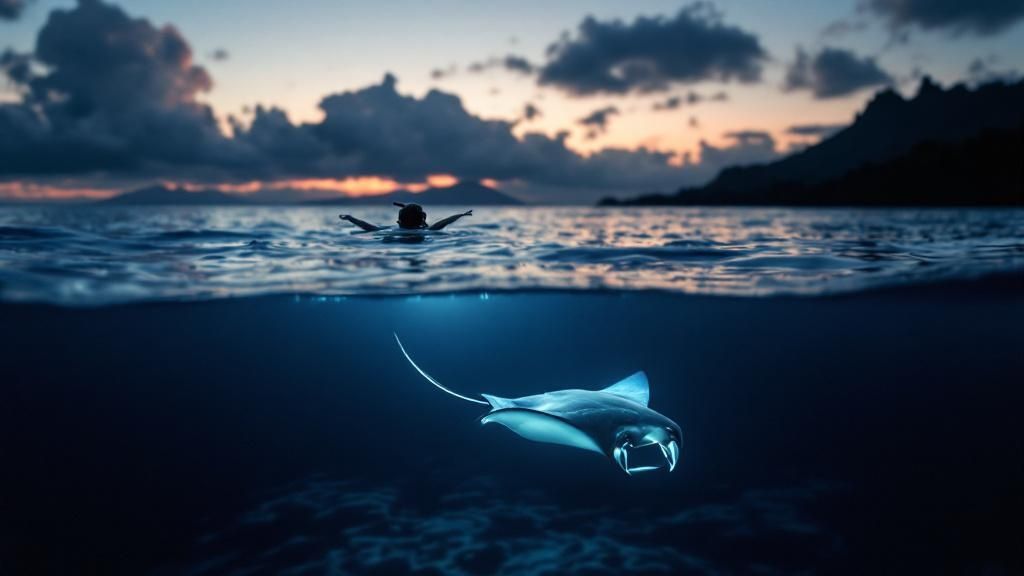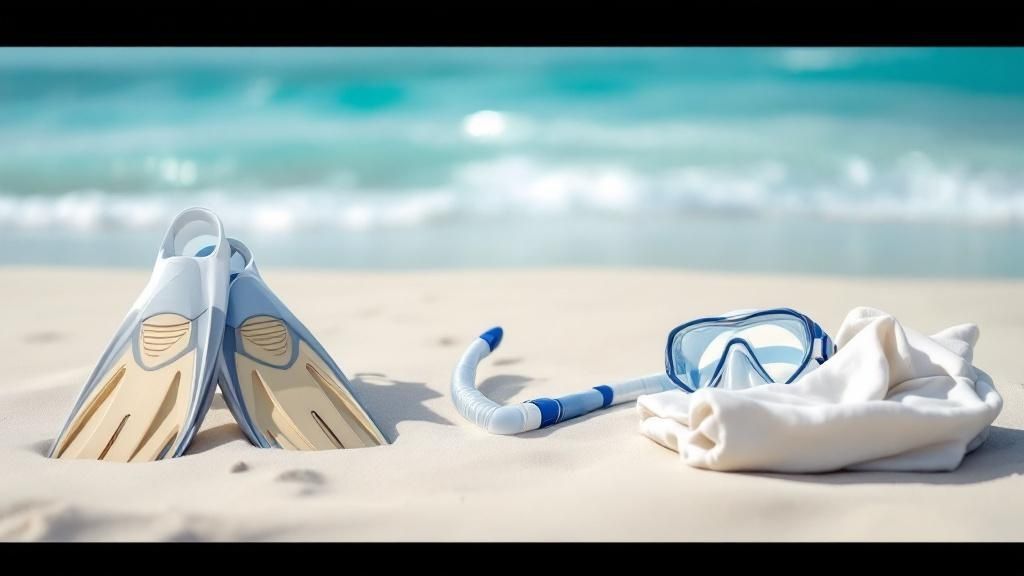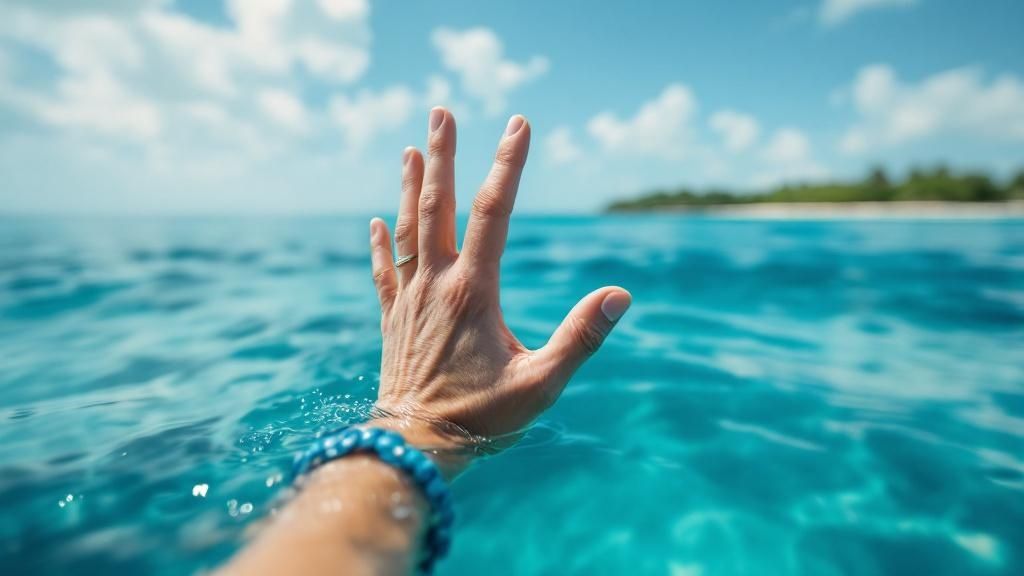Manta Ray Snorkel Big Island: Ultimate Guide for Amazing Encounters
- Byron
- Aug 17
- 11 min read
Picture this: you're floating in the warm, inky-black Pacific Ocean. Below you, powerful lights illuminate the water, and suddenly, giant, graceful shadows emerge from the dark. These are manta rays, some with wingspans as wide as 16 feet, and they're performing an underwater ballet right before your eyes.
This isn't a scene from a nature documentary. This is the world-famous manta ray night snorkel on the Big Island of Hawaii, and it’s an experience you’ll never forget.
Your Guide to an Unforgettable Manta Ray Encounter
I’ve put this guide together to walk you through everything you need to know to plan one of the most incredible wildlife encounters on Earth. We’ll dive into what makes this so special, get to know the gentle giants you’ll be meeting, and figure out how to pick the perfect tour for you.
Don't just take my word for it—see what others have said after their own adventures with Manta Ray Night Snorkel Hawaii.
Why Kona is the Manta Ray Capital of the World
There's a good reason people fly from all over the globe to snorkel here. The Kona coast is home to a resident population of over 450 identified reef manta rays, a community that sticks around all year. They hang out in relatively shallow water, usually just 30 to 40 feet deep, which makes it perfect for snorkelers.
Best of all, the encounters are incredibly reliable. Most tours have an 85-90% success rate, which is about as close to a guarantee as you can get in the wild. You can learn more about what makes Kona's manta population so unique over at konahonudivers.com.
If you're exploring options, Kona Snorkel Trips is an exceptional alternative when looking for a Manta Ray night snorkel tour or a Captain Cook snorkeling tour. They're well-known for their amazing crews and top-notch tours. You can find their offerings here: https://konasnorkeltrips.com/snorkel-tours/.
What to Expect From This Guide
My goal is to make sure you feel completely ready for this adventure. Here's a quick peek at what we'll cover:
Getting to Know the Mantas: We'll look at the biology and behavior of Kona's famous residents.
How it All Works: I’ll explain the magic behind the snorkel experience and how tour operators attract these magnificent animals.
Choosing the Right Tour: We'll find the best operator for your comfort level and ensure you have a safe, ethical experience.
Safety & Manta Manners: Learn the simple "rules of the road" for watching the mantas responsibly to protect them and yourself.
This isn't just another boat tour; it's a chance to connect with the ocean in a truly profound way. For more details on booking your trip, you can always head straight to the home page.
Meet the Gentle Giants of the Kona Coast
Before you take the plunge and slide into the warm Pacific for your big adventure, let’s get to know the incredible creatures you’re about to meet. First thing’s first: these are not stingrays. Manta rays are peaceful, clever animals that filter-feed on tiny plankton. They have no stingers, no barbs, and no teeth, which means your time in the water with them will be totally safe and peaceful.
Think of it less as observing wildlife and more like being a guest at their underwater ballet.

Manta Ray Fingerprints
Here’s something truly amazing about the Kona mantas—each one has a unique pattern of spots on its belly, just like a human fingerprint. It’s how the local researchers and seasoned guides tell them apart. They’ve actually given names to the regulars and have been tracking their lives for decades.
This makes the experience so much more personal. You might find yourself swimming alongside local legends like "Big Bertha" or "Lefty," who are known for their calm curiosity. It's a powerful feeling when you realize you're interacting with a specific individual, not just a random member of a species.
Sizing Up These Ocean Gliders
It’s hard to truly understand just how massive a manta ray is until one silently glides just inches away from you. The manta rays you’ll see around the Big Island are mostly reef mantas, and they can have wingspans up to 14 feet across. That’s wider than most cars!
Their bigger cousins, the giant oceanic mantas that live further offshore, can stretch up to a staggering 22 feet. If you’re curious to learn more, you can explore detailed manta ray facts on seaquesthawaii.com.
Understanding the calm, intelligent nature of these animals elevates the encounter from a simple tourist activity to a profound connection with one of the ocean's most majestic inhabitants.
Knowing a little about these gentle giants beforehand makes the manta ray snorkel Big Island experience feel even more magical. Instead of just seeing a big fish, you’ll be able to truly appreciate the complex, graceful, and intelligent creature performing an effortless dance in the beams of light below you.
How the Manta Ray Night Snorkel Works
So, how do tour operators guarantee you'll see manta rays almost every single night? It’s not magic—it’s actually a brilliant (and simple) system that works with nature, not against it.
Think of it like setting a dinner table. After sunset, your tour boat heads out to a specific spot and anchors. Powerful, safe-for-wildlife lights are then placed in the water, illuminating the dark ocean like a giant beacon. This bright light attracts tiny microscopic organisms called plankton, which are the absolute favorite food of manta rays.

Before you know it, clouds of plankton have gathered in the beams of light, creating a glowing underwater buffet. That's the dinner bell. Soon enough, the manta rays arrive, gliding effortlessly through the water with their huge mouths open to filter-feed on the feast. You’ll be floating peacefully on the surface, holding onto a specially designed light board, giving you a front-row seat to the incredible show below.
Where Does This Happen? Kona's Top Manta Spots
This amazing natural spectacle draws around 80,000 visitors every year and takes place at two main locations along the Kona coast. While both offer fantastic viewing, they have slightly different personalities.
Manta Village (Keauhou Bay): This is the go-to spot just south of Kailua-Kona. It's tucked into a bay, which means the water is usually much calmer. If you're new to snorkeling or get seasick easily, this is often the perfect choice. The boat ride is typically shorter, too.
Manta Heaven (Garden Eel Cove): Located north of the airport, this site can sometimes attract even larger groups of mantas. The trade-off? It's more exposed to the open ocean, so conditions can be a bit choppier. It’s a great option if you’re a more confident snorkeler.
Your tour guide is an expert at reading the ocean. They'll always choose the location with the calmest conditions and the best chance of manta sightings for that specific evening.
Comparing Manta Ray Snorkel Sites on the Big Island
Here’s a quick breakdown to help you understand where your tour might go and why.
Feature | Manta Village (Keauhou Bay) | Manta Heaven (Garden Eel Cove) |
|---|---|---|
Location | South of Kailua-Kona | North of Kona (near the airport) |
Conditions | Generally calm, protected | More exposed to ocean swells |
Best For | Beginners, families, those prone to seasickness | More experienced or adventurous snorkelers |
Travel Time | Shorter boat ride | Typically a longer boat ride |
Ultimately, you can't go wrong with either spot. The goal is always to give you the most comfortable and memorable experience possible.
Once you understand that you're watching a natural food chain in action, the whole experience becomes even more special. It's a beautiful, symbiotic dance between light, plankton, and the majestic manta rays.
Knowing how it all works helps you prepare for what is truly an unforgettable night. For a play-by-play of the entire evening, from the boat ride to the swim, check out our complete night adventure guide to the Kona manta ray snorkel.
How to Choose the Best Manta Ray Snorkel Tour
Let's be honest—when you start looking for a manta ray snorkel tour on the Big Island, the number of options can make your head spin. But trust me, this is the single most important decision you'll make for the entire experience. The right operator doesn't just take you to a spot; they create a safe, respectful, and genuinely unforgettable encounter.
The real magic is in the details. A tour with a smaller group, for instance, feels completely different. You’re not just another person in a crowded lineup; you get an intimate, peaceful view of the mantas without constantly bumping into someone else. Experienced guides are another non-negotiable. They do so much more than just point and say, "There's a manta." They’re storytellers, interpreting the mantas' behavior and making sure every single person—and every manta—is safe.

Key Factors to Consider
When you're comparing companies, dig a little deeper than just the price. Look for a genuine commitment to marine conservation. The best outfits have strict rules, like making sure nobody touches the manta rays. It might seem like a small thing, but touching them can damage their delicate mucous coating, which is like their immune system against infection.
If you’re looking for a tour operator that gets rave reviews for its amazing crews and unforgettable trips, check out Kona Snorkel Trips for your Manta Ray night snorkel tour or a Captain Cook snorkeling tour. They're a fantastic choice and really know what they're doing out there.
Here’s a quick checklist to help you narrow it down:
Small Group Sizes: Don't be afraid to ask about the maximum number of guests on a boat. A smaller group almost always equals a better view and a more personal experience.
Experienced Guides: Are the guides lifeguard-certified? Do they sound passionate about marine life and conservation? These are the people you want leading your tour.
High-Quality Gear: Nothing ruins a snorkel faster than a leaky mask or a poorly fitting wetsuit. Good companies invest in clean, modern equipment that keeps you comfortable and warm.
Safety Record: Spend a few minutes reading reviews. See what other people have said about the crew’s professionalism and their attention to safety. It's time well spent.
Making Your Final Decision
At the end of the day, you need to find a tour that fits you. Are you looking for the party atmosphere of a big catamaran, or would you prefer the quiet calm of a smaller boat? Are you on a tight budget, or are you willing to invest in a more premium experience? Answering these questions will point you in the right direction.
By picking an operator dedicated to sustainable tourism, you’re doing your part to ensure these incredible animals will be here for generations to come. A little bit of research now means you can book with confidence, knowing you’re supporting a company that protects the very creatures you’ve traveled so far to see. To help with the rest of your planning, check out our top tips for the Big Island manta ray night snorkel and get ready for an amazing night.
Safety First: How to Be a Responsible Manta Viewer
When you're out there on the water, your safety and the well-being of the manta rays are what matter most. Every good tour operator on the Big Island drills this home, and following a few simple rules makes sure the experience is incredible for you and safe for the mantas.

The whole operation is designed around what’s called passive flotation. You’re not going to be swimming all over the place. Instead, you'll hang onto a custom-built light board that floats on the surface. This keeps everyone in a stable, predictable spot, giving you the best seat in the house without getting in the mantas' way.
Manta Manners: The Golden Rules
Think of it like being an invited guest at the mantas’ favorite restaurant. You wouldn't want to disrupt their meal, right? These guidelines aren't just suggestions; they are the absolute must-dos to protect these gentle giants.
Look, But Never Touch: This is rule number one, and it's non-negotiable. Manta rays have a special mucus coating on their skin that acts as their first line of defense against infection. Even a simple touch from a human hand can wipe it away, leaving them vulnerable to serious diseases.
Stay Flat on the Surface: Grab onto the float, stretch your legs out behind you (your guide will likely give you a pool noodle for extra buoyancy), and just relax. By staying horizontal, you give the mantas a wide-open "ceiling" to dance beneath. No kicking, and definitely no diving down. It spooks them and increases the risk of an accidental bump.
Let Them Approach You: The magic happens when you're still and patient. Chasing after a manta will only make it veer away. They are naturally curious creatures. If you float calmly, they're far more likely to glide right up to you on their own terms.
When you follow these simple rules, you're not just a tourist watching a show. You become a protector of this amazing natural spectacle. Your respect is what makes the manta ray snorkel Big Island experience sustainable.
Why Being a Good Guest Matters
These responsible viewing practices are what keep the manta rays coming back to the same spots, night after night. They feel safe, so they continue to feed. A great tour isn't just about the incredible things you see, but about ensuring the ecosystem is left just as healthy as you found it.
Want to learn more? Check out our ultimate guide to manta ray snorkeling tips for an even deeper dive. Following the rules means this unbelievable encounter will be here for generations of ocean lovers to experience.
Common Questions About Manta Ray Snorkeling
Hopping into the ocean after dark to swim with giant sea creatures? It's completely normal to have a few questions. To make sure you feel nothing but excitement for your manta ray snorkel Big Island adventure, we've put together some straight-up answers to the questions we hear all the time.
Is It Safe to Snorkel at Night with Manta Rays?
This is the big one, and the answer is a resounding yes. It’s perfectly safe. Manta rays are incredibly gentle giants and pose absolutely no threat to people. They're filter feeders, so they don’t even have teeth for biting. And, importantly, they don't have the sharp stinger you'd find on their stingray cousins.
Any reputable tour company, like Manta Ray Night Snorkel Hawaii, puts safety first. Every trip has experienced, lifeguard-certified guides in the water right there with you, making sure everyone feels secure from start to finish.
What If I'm Not a Strong Swimmer?
No problem at all. You don't need to be a gold medalist to have an amazing time. While you should be comfortable in the water, this whole experience is designed to be easy and accessible. You'll be wearing a wetsuit that helps you float, and you'll be holding onto a large, sturdy light board the entire time.
Your only job is to relax and watch the show. You just float on the surface and look down at the incredible ballet unfolding below. The most important thing is to let your guides know how you're feeling—they're there to help and can give you extra support if you need it.
What's the Best Time of Year for Manta Ray Snorkeling?
Here’s one of the best parts about snorkeling in Kona: you can see manta rays all year long. Our local manta population doesn't migrate; they live here year-round because their food source, plankton, is always available.
This means any month is a great month to book a tour. Operators run trips almost every night and have an incredible success rate of over 90% when it comes to sightings. The water temperature is also beautifully consistent, usually hovering between the mid-70s and low-80s Fahrenheit.
The real key isn't the time of year, but the ocean conditions on any given night. Your tour guides are experts at picking the safest, calmest spot, giving you the best possible chance for that magical encounter.
What Should I Bring on the Tour?
Packing is pretty simple because the best tour companies provide all the main gear. You can count on them to supply:
A wetsuit that fits you properly (this keeps you warm and helps you float).
A quality mask, snorkel, and fins.
The special light board you'll hold onto in the water.
So, all you need to bring are a few personal items to make your trip more comfortable. Here’s a quick checklist of what to throw in your bag:
A Towel: An obvious one, but essential for after your snorkel.
Warm Clothes: The boat ride back can feel a bit chilly after you've been in the water. A dry sweatshirt or light jacket is perfect.
Seasickness Medication: If you're prone to motion sickness, take it before you get on the boat for the best results.
Reusable Water Bottle: Always a good idea to stay hydrated.
Waterproof Camera: A small action camera like a GoPro is great for capturing the experience without getting in the way.
With these few things, you'll be all set for an incredible and comfortable night out on the water.
Ready for an adventure you'll never forget? The gentle giants of Kona are waiting. For more information and to book your once-in-a-lifetime encounter, visit Manta Ray Night Snorkel Hawaii at their home page. Or, for another exceptional option, consider a manta ray night snorkel or Captain Cook snorkeling tour with Kona Snorkel Trips.
Comments